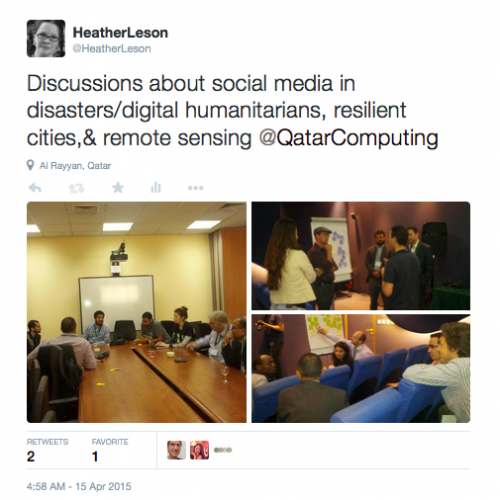How can we use advanced computing, human computing and social innovation to have impact in Qatar? Healthy lives, taking care of the environmental, youth engagement, resilient cities, social entrepreneurship and humanitarian response are some of the core Social Computing research activities at Qatar Computing Research Institute (QCRI)?
On Wednesday, April 15, 2015, QCRI hosted a small forum to discuss social innovation in Qatar. The session consisted of speakers from QCRI and partners as well as some informal discussion groups. Thank you for our guests and participants for this informative conversation.
The Qatar Red Crescent Disaster Management Camp was held in Doha, Qatar from March 31 – April 9, 2015. These are some early observations that I had on the use of technology and the opportunities for future research and collaboration:
We plan on expanding this dialogue in the future. Until then, your insights will inform both our strategic planning, research agenda and future activity collaborations.
QCRI’s Social Innovation Programme in Qatar is focused on four streams of research and activities:
- Smart and Resilient Cities
- Remote Sensing for Social Good
- Digital Humanitarians
- Social Media for Disaster
In the Resilient city discussion group we saw some opportunities with ICTQatar leading open data initiatives, QMIC working with traffic sensor data and the potential of sports data to provide insights into society. Collectively we agreed that we need to know more about resilience city and society ecosystems in Qatar. Some of the barriers included lack of policy and regulation in Qatar, community services need access to the data and
cellular data is hard to share.
The Remote Sensing group spent time thinking about blue sky uses for these tools and techniques. Some of the concepts tie directly into the Resilient City Group with opportunities to use phone traffic sensors, computer vision and drones and uavs for parking. Some of the potential imagery sources include landsat imagery, Planet Labs and Skybox (Google).
The Social Media for Disaster and Digital Humanitarian teams joined forces to delve into opportunities, barriers and new research items. Opportunities included a very diverse community (languages, cultures), engaged youth, access to technology/mobile devices and the sense of belonging in a geographically small but strategic area. The barriers include lack of civil society, language barriers, education levels and the fluidity of communities. Also, there is a need to reframe the concept of volunteering into opportunities for educational and society advancement. Research opportunities included understanding the needs/motivations of people, peer-to-peer transfer of knowledge, community development in Qatar and understanding social responsibility programs in Qatar.
Thanks again to the speakers, guests and my colleagues for a great morning.
